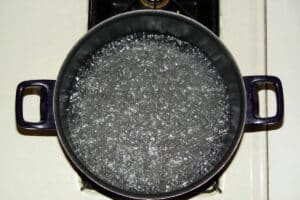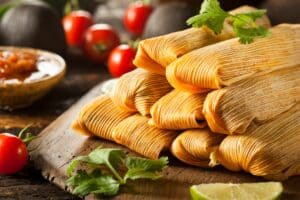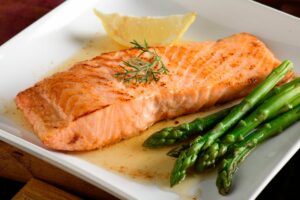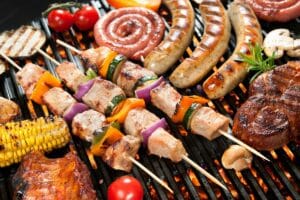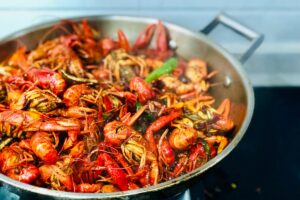While chicken is one of the most popular white meats in the Western hemisphere, cooking it is not so simple.
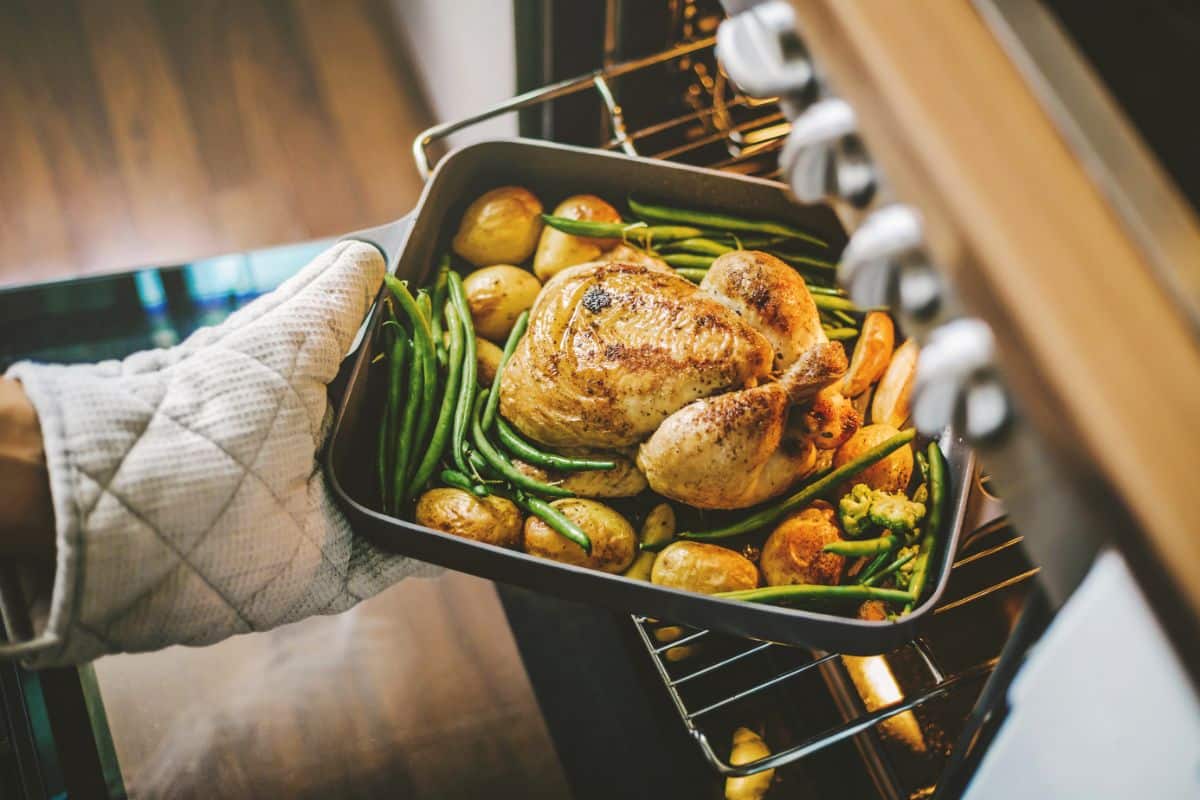
It is one of the only meats that cannot be served raw and doing so can have some disastrous effects.
Chicken must have an internal temperature of 165° Fahrenheit in order to be safe to eat. This ensures the harmful bacteria are killed and the chicken is juicy.
However, if you do not have a thermometer or want an easier way to tell when your chicken is done cooking then we have got you covered.
In this article, we discuss everything you need to know about cooking chicken.
Learn to cook chicken like a professional chef and ensure your family is always safe. Keep reading to find out more about cooking the highest consumed bird in America.
Consequences Of Eating Raw Chicken
Before we can even begin to think about cooking chicken, it is integral that we understand the consequences of eating chicken raw.
Raw chicken is the perfect home for a poisonous bacteria called Salmonella.
If raw chicken is consumed, you can end up with Salmonella poisoning which can be extremely harmful and even fatal.
Symptoms of Salmonella poisoning are:
- Diarrhea
- Fever
- Stomach Cramps
- Headache
- Nausea and Vomiting
Many victims of Salmonella poisoning may not experience symptoms for various days or even weeks after consuming raw chicken or Salmonella products.
This is why it is crucial for the chicken to be cooked perfectly before serving.
Working With Raw Chicken
Cooking chicken is part of the process that everyone is typically intimidated by. However, the work begins well before your chicken touches the pan or goes in the oven.
It begins as soon as you purchase raw chicken from the store or butcher.
The first step is to ensure your chicken is covered and stored in the refrigerator until you want to use it. Now, you must wash everything.
And we mean everything that the chicken touches. Surfaces, chopping boards, your hands, knives, spoons, etc.
You want to give everything a good clean with an antibacterial cleaner.
Otherwise, the bacteria could remain on your hands, surfaces, and utensils which will then be transferred all around your home and can be extremely harmful.
4 Ways To Tell When Chicken Is Done
Now that we know how to work with chicken properly and how to decrease the risk of Salmonella poisoning, we can get into the methods for checking the progress of your chicken.
Below are 4 ways to tell when chicken is done cooking. Using any of those methods will ensure your chicken is cooked to perfection and that you are serving juicy chicken to your friends and family.
1. Color Of The Juices
When you purchase your chicken you may see some of the juices in the packaging.
They should be a light pink and this is a great indicator for when cooking chicken. Once your chicken is cooked the juices will turn from pink to clear or white.
If the juices are clear or white then your chicken is cooking. If the juices are still tinged pink then it needs more time to cook through.
This method only works for chickens. It should not be applied when cooking other meats.
The clear or white juices from the cooked chicken can then be used to make gravy or be added to various sauces for more flavor.
2. Cut It Open
This is probably the most common method for checking the doneness of chicken.
Take a sharp knife and make a small incision on the thickest part of the meat. Use a fork to lightly pull the chicken apart and check the color of the meat inside.
The chicken should be white all the way through. If there are any pink hues on the meat then your chicken needs more time.
This is the most common way to check if your chicken is cooked properly, although, many people can end up tearing their chicken apart.
You only need to make a small incision into the thickest part of the meat and then when it is placed back into the pan or the oven the incision will close over.
Your guests will never know. Although, they will probably appreciate the fact that you are making sure not to serve them raw chicken!
3. Shrinking Of The Meat
Much like most meats, as the chicken cooks the juices are released and the meat decreases.
A common mistake that people make is thinking that their chicken is finished cooking because the outside of the meat is white or even has a golden sear.
However, if your chicken is white on the outside but is still the same size as when it began cooking, it is not ready to eat. The chicken should shrink considerably as it cooks.
You may still want to make a small incision into the chicken to ensure that it is cooked all the way through.
But the shrinking of the meat is still a good start to knowing if your chicken is cooked properly.
4. Use A Thermometer
The best and most accurate way to know if your chicken is done is to use a thermometer.
Once you think your chicken is cooked or your timer goes off, stick the thermometer into the thickest part of the meat.
It should read 165° Fahrenheit (74°C) for a breast or thigh and 180° Fahrenheit (82°C) for a whole chicken.
Anything below these numbers and your chicken is not cooked and needs more time. If your chicken is well over the recommended degrees then you may risk it burning and becoming dry.
This is the perfect temperature and is used by chefs and home cooks all over the world. It is the best way to know if your chicken is done.
It minimizes the risk of Salmonella poisoning and ensures your chicken is juicy and flavorful when served to your guests.
How To Know A Whole Chicken Is Cooked
White and dark flesh can both be enjoyed in delicious ways when a whole chicken is roasted, and it also makes a filling meal for a small family.
Something about the delicious aroma of a fully roasted chicken makes it gratifying and appealing.
As mentioned above, the best way to know if your chicken is cooked is with a thermometer.
But, there are going to be times when you don’t have a thermometer to hand and need other ways to know if your whole chicken is cooked to perfection.
There is another way to check if your whole chicken is cooked. Hold the chicken leg’s bone and jiggle it after you remove the roast from the oven.
When they are moving and almost feeling like they could fall off the bone, there shouldn’t be any resistance.
Of course, you can use the other methods mentioned above such as the juices running clear. But if you want to ensure your chicken is cooked properly, use a thermometer.
How Long To Cook Chicken
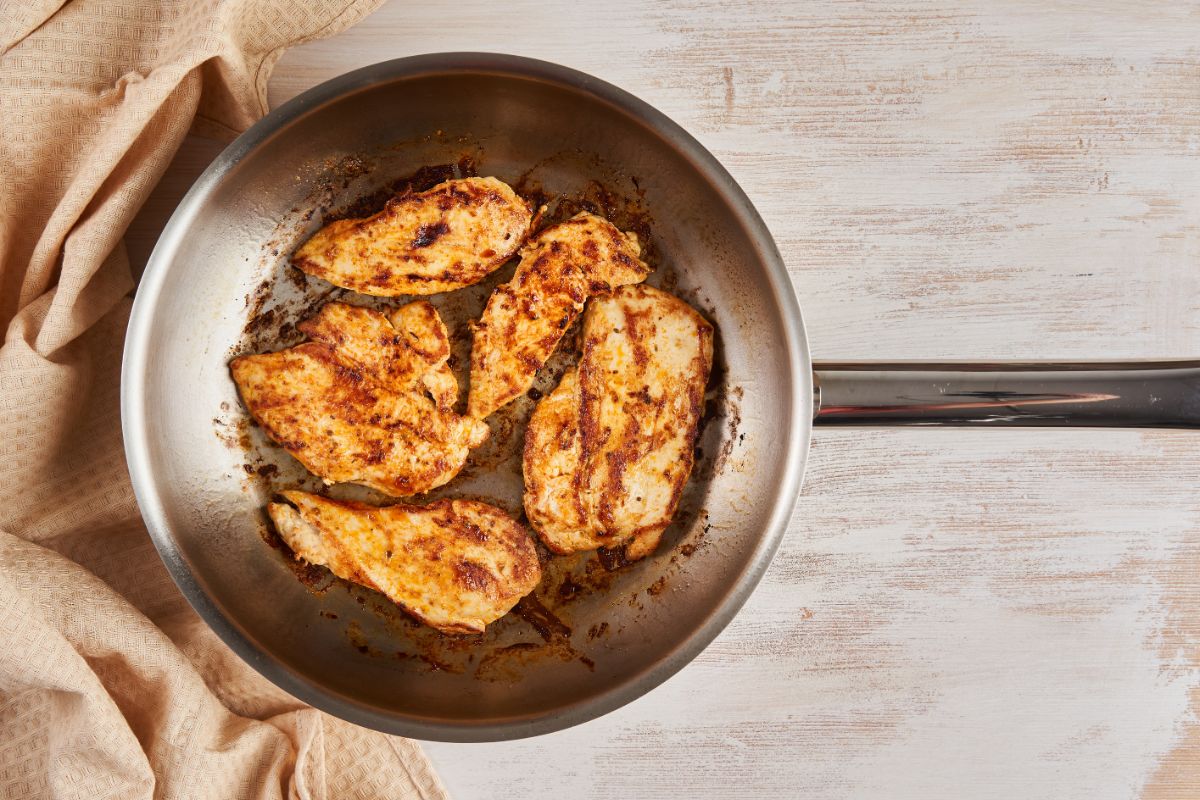
This is not a simple, one fits all, situation. Factors such as the way you are cooking the chicken, the size of the chicken, and the chicken itself.
The length of time a chicken takes to cook will change every time you cook. Even if you are following a recipe to the letter.
The main factor that will determine how long a chicken takes to cook is the temperature of the oven. Below are rough times you need to cook your chicken for, depending on the temperature of your oven:
- 350° F. When baking chicken at 350°F in the oven then you are going to need around 25-30 minutes for it to be done. This can change depending on the size and thickness of the chicken.
- 375°F. It can take around 20-25 minutes for a chicken to cook completely in the oven. It may take longer if your chicken is bigger or if your oven is not properly tempered.
- 400°F. Cooking your chicken at 400°F will only take around 18-25 minutes. This temperature is not the best when cooking chicken as it is easy to overcook and even burn your chicken.
A good rule of thumb is to weigh your chicken in order to figure out the cooking time.
It is generally around 45 minutes per kilogram of chicken plus 20 minutes. This is only when roasting your chicken in the oven.
The way to determine if your chicken is done is to use a thermometer and make a small incision into the thickest part of the chicken to check the color of the meat.
How To Avoid Overcooking Your Chicken
If you are new to cooking chicken or the thought of giving your dinner party Salmonella poisoning gives you anxiety then you probably end up overcooking your chicken.
If you want your chicken to be cooked all the way through while still being tender and juicy then you have to check out the tips below.
1. Let The Chicken Rest
Once your chicken is cooked all the way through, you need to let it rest.
Like you would with Thanksgiving turkey or a sirloin steak, you have to let your chicken rest and to really soak up the juice that escaped while cooking.
Chicken only needs to rest for around 5 minutes before it is sliced and served. This is the perfect amount of time to let the chicken lock in all that flavor and to cool slightly before your guests dig in.
It also allows the chicken to solidify which prevents it from breaking when you make your cuts into the meat.
2. Use A Detailed Recipe
This may seem silly but a good, detailed recipe can make all the difference when it comes to cooking the perfect chicken.
You need a recipe that walks you through every step of making delicious chicken in the oven or pan.
It should have instructions on what type of chicken to use, how to check the internal temperature, and how hot to heat the oven or skillet.
These simple details will make your cooking experience a lot smoother and take a lot of the pressure off of you. Relax and enjoy the smell of your chicking cooking in the oven.
3. Add Water
Whether you are pan-frying your chicken, roasting it in the oven, or slow-cooking it in the crock pot, it can come out dry and overdone. This is what we want to avoid.
When cooking your chicken in the pan, once it is seared on the outside, add a small amount of water or broth, cover it with a lid or aluminum foil, and let it cook through.
You are essentially poaching your chicken which keeps it moist and juicy throughout the cooking process.
Follow these steps to ensure your chicken is juicy, succulent, and delicious. Using broth will add more flavor but water does the job perfectly.
You only need a small amount of water which will create steam and when you cover the chicken, the steam will build and enter the chicken making it perfect.
Common Mistakes When Cooking Chicken
If you follow all of the guidance above from checking the juices are running clear to letting the chicken rest yet you are still serving tasteless, overcooked chicken then you need the tips below.
Below are some of the most common mistakes people make when cooking chicken. You can avoid these mistakes and serve juicy chicken every time.
1. Not Finishing Chicken In The Oven
The key to keeping your chicken from coming out overcooked and rubbery is to sear it in a pan on medium-high heat before continuing to cook it at a lower temperature in the oven.
This helps the outside to become nice and crispy while the inside remains moist and succulent.
2. Not Marinating Properly
On its own, chicken is typically a rather bland meat. The spices, herbs, and marinades are what give it all that gorgeous flavor we love.
Yet, most people don’t know how to marinate their chicken properly.
The way to marinate your chicken is to poke holes using a fork all around the chicken.
Pour your marinade all over the chicken, using a spoon or brush to make sure it goes into every nook and cranny of the chicken.
Allow it to rest and soak it all in the juices and flavor of your marinade for around 30 minutes before you begin cooking.
3. Your Chicken Has Gone Bad
Contrary to popular belief, raw chicken goes bad rather quickly. Yet, many home cooks will still try to cook chicken even after it has gone bad which can have disastrous effects.
There are three ways to make sure your chicken has not gone off:
- Change in color: Fresh, raw chicken has a gorgeous pink color that is similar to pink salmon. However, once it begins to go bad it turns to a gray color.
- Bad odor: The smell of rotten raw chicken is really strong. It’s sometimes described as having a sour smell. It’s best to discard the chicken if it develops any form of stench.
- Hardness: If you have left your chicken out of the fridge or left it uncovered, the meat will begin to turn hard. This is a sure sign that your chicken has gone off and should be thrown in the trash immediately.
The Chicken Has Not Been Dried
A mistake that many people make is not patting their chicken down before applying spices and herbs. While you do not have to wash your chicken, it does need to be dried off.
Patting down your chicken before you begin cooking will give it a nice brown crisp that everyone loves.
For the best results, let the meat air-dry in the refrigerator for a few hours without any packing. Before cooking, take it out of the refrigerator and blot it dry with paper towels.
Cooking Straight From The Fridge
It’s true that you shouldn’t leave the meat out on the counter for a long period of time before cooking it, but it’s a good idea to let the thawed meat remain outside of the refrigerator for around 15 minutes before doing so.
This will increase the likelihood that the chicken will cook evenly by ensuring that the internal and external temperatures of the meat are generally the same.
3 Best Chicken Recipes
Now that you know how to tell when your chicken is done and the mistakes to avoid, we can begin discussing recipes. Below are 3 of the best chicken recipes for succulent, flavorful chicken.
1. Creamy Tuscan Chicken
This Creamy Tuscan Chicken is one of the best chicken recipes for any occasion. Garlic, tomatoes, and cream are all abundant in it. It’s cheerful and simple, and it works well in both the summer and the winter.
Serve with your favorite sides such as pasta, rice, or even mashed potatoes!
2. Slow-Cooker Chicken Noodle Soup
Whenever you are feeling a little under the weather, this Slow-Cooker Chicken Noodle Soup is perfect. Filled with veggies, protein, and nutrients that will make you feel better in no time.
Serve with a slice of crusty bread for the perfect lunch or dinner throughout the week.
3. Sheet Pan Harrisa Chicken & Sweet Potatoes
If the idea of doing a mountain of dishes at the end of the night makes you never want to cook again then you have to make this Sheet Pan Harissa Chicken & Sweet Potatoes recipe.
Using just one pan you can have a flavorful meal that the entire family can enjoy.
Depending on the brand and type, harissa can be either mild or spicy in terms of heat. Cayenne pepper can always be added to the marinade if you want your food spicy.
Final Thoughts
Cooking chicken is always an intimidating task. Whether you are completely new to cooking or a Michelin Star chef, there is always a slight chance that your chicken is undercooked.
We are to help you know when your chicken is done. From checking the color of the juices to checking the internal temperature, you will never serve your family raw chicken again.
We have even included some of the most common mistakes people make when cooking chicken.
You know what to avoid and how to properly prep your chicken to cook the most delicious, succulent, perfectly cooked chicken you can!
Frequently Asked Questions
The USDA has determined that the chicken must have an internal temperature of 165°F in order to be eaten.
According to the USDA, even completely cooked fowl occasionally exhibit a reddish tinge in the meat and juices.
When cooking chicken breast that hasn’t been coated or marinated in any way, the color will be white.
They may be done yet still seem pink near the bone if you are cooking bone-in chicken thighs.


